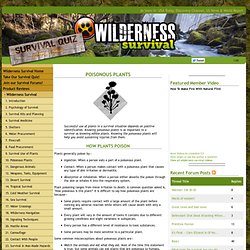

Poisonous Plants Basics. Plants are amazing creatures that produce many great benefits for human consumption.

We get most of our medicines from plants, our foods and even our beauty products. Still, there are poisonous plants among the wild edible plants that people need to be aware of when it comes to consuming them. To be responsible foragers we should have a few basic pieces of knowledge in our pockets to stay safe. By being smart about plant harvesting and consumption, we need not be scared. So what are poisonous plants anyways? If you remember one simple fact, it will help you realize why plants produce certain compound to deter predators – PLANTS CANT RUN! If you were to accidentally chomp on a Skunk Cabbage you would become very familiar with oxalate crystals that are like needles that stab you all the way down! Besides defending themselves, plants also make poisonous or toxic substances as byproducts from their usual metabolic processes. Stay Calm and Act Fast. Know your plants and plant families! Poisonous Plants 1.
Successful use of plants in a survival situation depends on positive identification.

Knowing poisonous plants is as important to a survivor as knowing edible plants. Knowing the poisonous plants will help you avoid sustaining injuries from them. Plants generally poison by-- Ingestion. When a person eats a part of a poisonous plant. Plant poisoning ranges from minor irritation to death. Some plants require contact with a large amount of the plant before noticing any adverse reaction while others will cause death with only a small amount. Some common misconceptions about poisonous plants are-- Poisonous Plants 2. Plants basically poison on contact, ingestion, or by absorption or inhalation.

They cause painful skin irritations upon contact, they cause internal poisoning when eaten, and they poison through skin absorption or inhalation in respiratory system. Many edible plants have deadly relatives and look-alikes. Preparation for military missions includes learning to identify those harmful plants in the target area. Positive identification of edible plants will eliminate the danger of accidental poisoning. There is no room for experimentation where plants are concerned, especially in unfamiliar territory. Description: The castor bean is a semiwoody plant with large, alternate, starlike leaves that grows as a tree in tropical regions and as an annual in temperate regions. Habitat and Distribution: This plant is found in all tropical regions and has been introduced to temperate regions.
Description: This tree has a spreading crown and grows up to 14 meters tall. Poisons. Top 10 Most Dangerous Plants in the World. 1. Most likely to eat a rat Giant Pitcher Plant: Nepenthes attenboroughii Discovered more than 5000 feet above sea level on Mount Victoria in the Philippines, the giant, carnivorous pitcher plant secretes a nectar-like substance to lure unsuspecting prey into a pool of enzymes and acid. A series of sticky, downward ribs makes it nearly impossible for trapped prey to escape. The plant's 30-centimeter diameter is large enough to trap unlucky rodents, but insects are its most common meal. 2. Castor Bean Plant: Ricinus communis Castor-bean plants can be purchased at just about any garden center, despite containing the deadly poison ricin. 3. Western Water Hemlock: Cicuta douglasii Deemed the most "violently toxic plant that grows in North America" by the USDA, the water hemlock contains the toxin cicutoxin, which wreaks havoc on the central nervous system, causing grand mal seizures--which include loss of consciousness and violent muscle contractions--and eventually death, if ingested.